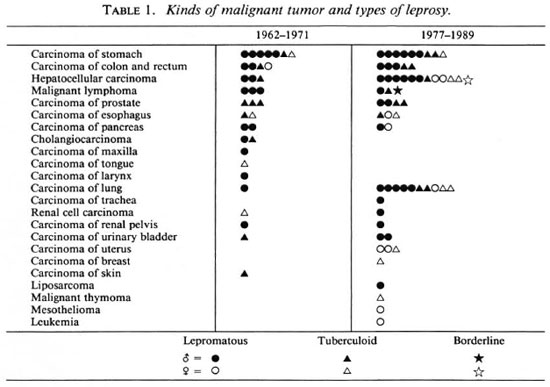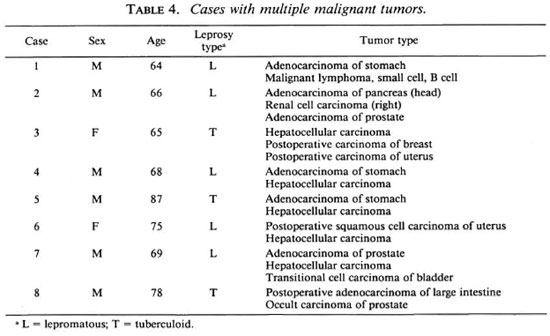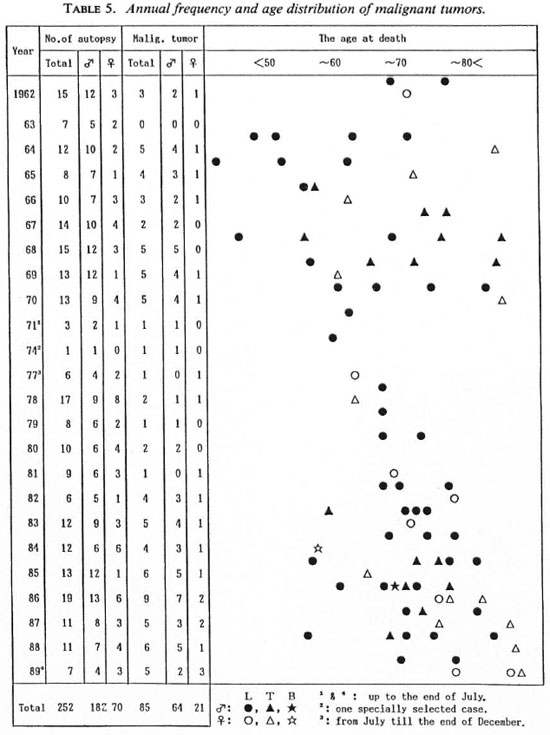- Volume 58 , Number 4
- Page: 697–703
Leprosy and Malignancy: Autopsy Findings of 252 Leprosy Patients
ABSTRACT
The occurrence of malignant tumors in leprosy patients was studied in 252 autopsied cases. Malignant tumors were found in 33 out of 110 autopsy cases from 1962 to 1971, and in 51 out of 141 autopsy cases from 1977 to 1989 (until July). In 1974, a lepromatous case with Kaposi's sarcoma was autopsied. The incidence of malignant tumors in our 252 cases were 33.7% (85 out of 252). Carcinoma of the alimentary system was most common: stomach, liver and large intestine, in that order. There was an increased number of hepatocellular carcinoma closely related to liver cirrhosis. Carcinoma of the lung has increased remarkably in leprosy patients quite recently. Malignant lymphoma was the most common of the nonepithelial malignant tumors, and four of these cases were seen in lepromatous leprosy patients. Eight cases showed double or triple cancers; seven of these were autopsied during 1977 to 1989.Further studies should be done to ascertain which types of leprosy showed the highest incidence, and which sex showed more frequent malignant tumors.
RÉSUMÉ
La survenance de tumeurs malignes chez des malades de la lèpre a été étudiée chez 252 cas autopsiés. Des tumeurs malignes ont été trouvées chez 33 parmi 110 cas autopsiés entre 1962 et 1971, et chez. 51 parmi 141 cas autopsiés de 1977 et 1989 (jusqu'en juillet). En 1974, un cas lépromatcux avec un sarcome de Kaposi fut autopsié. L'incidence des tumeurs malignes dans nos 252 cas était de 33.7% (85 parmi 252). Les carcinomes du tractus digestif étaient les plus fréquents: estomac, foie, et gros intestin, dans cet ordre. Il y avait une augmentation du nombre de carcinomes hépatoccllulaires, en association étroite avec la cirrhose hépatique. Les carcinomes pulmonaires ont assez récemment augmenté de manière remarquable chez les malades de la lèpre. Le lymphome malin était la tumeur maligne non épithéliale la plus commune, et quatre de ces cas ont été observés chez des patients lépromateux. Huit cas ont montré des cancers doubles ou triples; sept de ceux-ci ont été autopsiés durant la périodede 1977 à 1989. Des études ultérieures devraient être faites pour découvrir quels types de lèpre montraient la fréquence la plus élevée, et quel sexe montrait plus fréquemment des tumeurs malignes.RESUMEN
Se estudió la ocurrencia de tumores malignos en autopsias de 252 casos de lepra. Se encontraron tumores malignos en 33 de 110 autopsias efectuadas de 1962 a 1971, y en 51 de 141 autopsias de 1977 a Julio de 1989. En 1974 se encontró un caso lepromatoso con sarcoma de Kaposi. La incidencia de tumores malignos en los 252 casos fue del 33.7% (85 de 252). El carcinoma del sistema alimentario (estómago, hígado e intestino grueso, en ese orden) fue el más común. Hubo un número incrementado de carcinoma hepatocelular estrechamente relacionado a cirrosis hepática. El carcinoma pulmonar en los pacientes con lepra ha aumentado considerablemente en los últimos tiempos. El linfoma maligno fue el más común de los tumores malignos no epiteliales; 4 de esos casos se encontraron en pacientes lepromatosos. Ocho casos mostraron cánceres dobles o triples; siete de estos casos se autopsiaron de 1977 a 1989.Se requieren más estudios para establecer que tipos de lepra muestran la mayor incidencia y cual sexo muestra mayor frecuencia de tumores malignos.
In Japan, most leprosy patients have been admitted into 13 national and three private leprosaria. Social segregation for leprosy control has forced the patients to spend their lives in these institutions. Statistically, the main cause of death since 1981 in Japan, where the average age is rapidly increasing, is said to be malignant tumors. These statistics include patients living in these leprosy institutions. Our concern is whether or not the incidence of malignancy in leprosaria is higher than in the general population, and what kinds of malignant tumors are most frequently found in leprosaria patients.
In 1972, we noticed that the incidence of malignant tumors among leprosy patients had increased in the National Leprosarium, Oku Komyo-en, Okayama, and we reported malignant tumors to be the most frequent cause of death as noted in autopsies which were relatively continuously done (8). We also estimated that malignant tumors were the most frequent cause of death in the general population as far back as 1981. This gap in time in noticing the increased incidence of malignancies occurred because the statistical death rate in the general population was not obtained by diagnosis at autopsy, but by clinical diagnosis. Tuberculosis had been listed as the main cause of death for a long time, and this continued until 1950 when cerebrovascular lesions replaced it. We have doubted the authenticity of such reports on the incidence of cerebrovascular disease. In 1978 we published a paper (3) which picked up a report by Netsky and Miyaji (6), who pointed out that cerebrovascular diseases were not the main cause of death in Japanese. They believed that malignant tumors were the most frequent cause of death in Japan. It seems that the main cause of death gradually shifted from tuberculosis to malignant tumors which appeared in Japanese whose average age advanced year by year. This paper presents the incidence of malignant tumors through autopsies in the leprosarium from 1962 to 1989 (until the end of July).
AUTOPSY
Autopsies had been done almost serially at the National Leprosarium, Oku Komyoen, throughout two periods, 1962 to 1971 and 1977 to 1989. The number of deaths in the first period was 131, of which 110 cases were autopsied. One-hundred-eightyfour patients died at the hospital during the second period, and 141 cases were autopsied. In 1974, an autopsy of a male lepromatous patient was done especially because he developed Kaposi's sarcoma. The total number of autopsy cases in this study was 252 leprosy patients.
RESULTS
Malignant tumors were found in 85 out of the 252 cases, including eight cases with multiple malignant tumors. The total number of malignant tumors was 96. Table 1 shows the kinds of malignant tumor with types of leprosy for the two periods (1962-1972 and 1977-1989). There was a case of Kaposi's sarcoma between these two periods (1974) that is not included in this figure.
The incidence of malignant tumors in the alimentary system was the most frequent. There were 7 cases of stomach carcinoma in the first period, 9 cases in the second period; 3 cases of hepatocellular carcinoma in the first period, 12 cases in the second period; only 1 case of lung carcinoma was seen in the first period, 10 cases in the second period of which 8 cases have been seen since 1986. Nonepithelial tumors were found in 11 cases. The most frequent tumor among them was malignant lymphoma, which was seen in 6 cases (all males, 4 lepromatous, 1 tuberculoid, and 1 borderline).
Table 2 shows the frequency of malignant tumors in the different types of leprosy in the 85 cases. The classification of leprosy in this table was based on that written on the autopsy request form. Malignant tumors were found in 53 of 168 lepromatous cases (31.5%), in 30 of 79 tuberculoid cases (38%), and in 2 of 5 borderline cases (40%). Table 3 shows the incidence according to sex. Malignant tumors were found in 64 of 180 male autopsied cases (35.5%) and in 21 of 72 females (29.2%). Table 4 shows cases with multiple tumors; 3 cases were triple malignancies, 5 were double malignancies. There was a case of stomach carcinoma with malignant lymphoma. Four other cases showed epithelial carcinomas. Table 5 shows the annual frequency and age distribution of malignant tumors. The number of patients with malignant tumors decreased relatively from 1978 to 1981. Malignant tumors of the tuberculoid patients were remarkably concentrated for 5 years 1966-1970, although the reason is not clear.
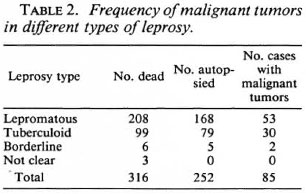
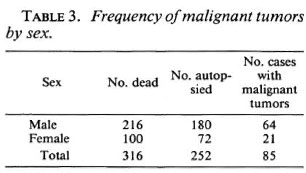
DISCUSSION
In 1939, Hayashi (4) reported on autopsy studies of 1200 leprosy patients during 1910-1937. The incidence of malignant tumors among them was 1.5%. Tuberculosis was the main cause of death during this period, as mentioned previously, and malignant tumors were rare in the general population. Autopsy studies about 50 years later showed a complete change. Our results show 8 5 malignant tumor cases out of 252 leprosy autopsy cases (33.7%). Sasaki and Kawatsu (9) also described an increase in malignant tumors in autopsies of 360 leprosy patients during 1955-1979. The incidence of malignant tumors among them was 30.8%, and in the last 5 years of the study, rose to 43.1 %. They mentioned the very high incidence of malignant tumors among male lepromatous patients. There are no reports of statistical autopsy studies in the general population because the autopsy rate is still low in Japan. The percentages for the causes of death in Japan are determined based on the final diagnosis of the clinical physician. There is difficulty in comparing our results, but the mortality rates per 100,000 population for various malignant tumors as published in 1989 by the Japanese Ministry of Health and Welfare indicate: stomach carcinoma, 46.3 in 1965 to 24.2 in 1987; liver carcinoma, 8.2 in 1965 to 14.5 in 1987; carcinoma of the large intestine, 3.2 in 1965 to 4.8 in 1987; carcinoma of the lung, 8.6 in 1965 to 17.7 in 1987. Carcinoma of the stomach has continued to be the most common malignant tumor in both sexes in Japan, but recently it has gradually decreased.
In our autopsy series concerning stomach carcinoma, there was a tendency to appear in males, with only 2 cases in female patients out of a total of 16 cases. A comparison of the two periods showed seven cases in the first and nine cases in the second period, with no tendency to decrease. There were 3 cases of hepatocellular carcinoma out of 33 cases in the first period (9.1%) and in the second period, 12 cases out of 61 malignancies (19.7%). There were more than twice as many cases in the second.
Hepatocellular carcinoma is closely related to liver cirrhosis, and the cases of liver cirrhosis have increased among leprosy patients recently. There were 12 cases of liver cirrhosis out of 110 autopsy cases (10.9%) in the first period and three cases associated with hepatocellular carcinoma (25%). In the second period, 29 cases of liver cirrhosis out of 141 autopsy cases (20.6%); 12 associated with hepatocellular carcinoma (41.3%). The cause of this liver cirrhosis is complicated. Longstanding administration of high doses of sulfone in the early days, 1947 to 1955, in Japan might be related to the pathogenesis. Only a few patients in our series were related to hepatitis-B infection. It is hard to exclude liver cirrhosis resulting from nonA or nonB hepatitis. The large number of these cases of liver cirrhosis is definitely different compared with the nonleprous population.
There were 11 cases of lung carcinoma in our series. In the first period, there was only one case; in the second period, the number increased to 10 cases of which 6 were seen after 1988. Among 360 autopsied cases (1955-1979), 12 were carcinoma of the lung in Sasaki and Kawatsu's report (9). These cases were concentrated in the last 5 years. The low incidence of carcinoma of the lung in leprosy patients is remarkably different from the general population. The report of the Japanese Ministry of Health and Welfare published in 1989 said that the mortality rate per 100,000 population for lung carcinoma was 3.9 in 1955, 6.6 in 1960, 8.6 in 1965, 10.5 in 1970, 12.6 in 1975, and 17.3 in 1985. This low incidence of carcinoma of the lung among leprosy patients might be related to the location of leprosy hospitals in areas where air pollution has been less severe. The other main reason is thought to be aging among the patients. It is difficult to clarify the effect of smoking, because these patients with lung carcinomas lived in leprosaria over several decades and many of the patients were not only smokers but heavy smokers. One tuberculoid case (no. 18, K68-3) had squamous cell carcinoma of the skin which developed from a plantar ulcer. Fleury and Opromolla (1) have described 16 cases of carcinoma arising from plantar ulcers, and concluded that the carcinoma was more frequently seen in leprosy patients of the borderline group. Carcinoma originating from the epidermis seldom metastasized; however, squamous cell carcinoma related to plantar ulcer seemed to metastasize more frequently.
A quite rare case of tracheal carcinoma (7) with metastasis was found in a 68-year-old lepromatous man (no. 42, K82-2). He had been a heavy smoker and had used a metal tracheotomy tube for 32 years. The carcinoma developed at the site of friction by the tube. This case was reported in 1984 (7).
Malignant lymphoma was found in six cases in our autopsy series. Details on these cases have been reported by Ishida, et al.(5). Malignant lymphoma is also related to immunosuppression. Four cases of malignant lymphoma were patients with lepromatous leprosy.
There was one case of Kaposi's sarcoma (no. 34, 74-1), an exceptional case between the first and second periods, and a special autopsy was done. The patient was a 59year-old man with lepromatous leprosy and was reported previously (2). To summarize: The association of Kaposi's sarcoma and leprosy was not causal but closely related with his immunodeficiency. Templeton (10) reported a study of 624 cases of Kaposi's sarcoma in Uganda, including a case of leprosy, but details were not described. Recently, the association of Kaposi's sarcoma with AIDS has become a serious medical and social problem.
Eight cases of multiple malignant tumors were found. The numbers of these cases have been increasing in the last several years. An annual autopsy report by the Japanese Academy of Pathology also revealed an increase in cases with multiple tumors year by year.
An interesting and controversial problem is whether the incidence of malignancy differs in the classification of leprosy or not; some believe malignancy occurs more frequently in the lepromatous type. This requires careful and more detailed consideration. However, we report one case of Kaposi's sarcoma and four cases of malignant lymphoma which appeared in lepromatous-type patients.
The differences between the incidences of malignancies in males and females need more observation. In our autopsy series, malignancy was found in 64 (35.5%) male patients and in 21 (29.2%) female patients (not statistically significant; p > 0.01).
Acknowledgment. The authors are grateful to their technical and clinical coworkers.
REFERENCES
1. FLEURY, R. N. and OPROMOLLA, D. V. A. Carcinoma in plantar ulcer in leprosy. Lepr. Rev. 55(1984)369-378.
2. FURUTA, M., AOSHIMA, T., MATSUMOTO, T., MATSUMOTO, S. and HASHIZUME, C. A case of Kaposi's sarcoma appearing in a patient with lepromatous leprosy. Lepro 43(1974)284-306.
3. FURUTA, M., OZAKI, M., HARADA , N., MATSUMOTO, S., NAGAO, E., SUGIYAMA, K., OGASAWARA, T. and MATSUMOTO, T. Frequency of cerebrovascular lesions in leprosaria. Jpn. J. Lepr. 47(1978)61-65.
4. HAYASHI, Y. Observation of 1200 autopsy cases of leprosy patients. Lepro 10(1939)27-51.
5. ISHIDA , Y., MATSUMOTO, S., OBARA , A., HARADA, N. and FURUTA , M. Malignant lymphoma in leprosy patients of our autopsy series. Jpn. J. Lepr. 58(1990)166-171.
6. NETSKY, M. G. and MIYAJI , T. Prevalence of cerebral hemorrhage and thrombosis in Japan, Study of the major causes of death J. Chron. Dis. 29(1976)711-722.
7. OBARA , A., HARADA , N., MATSUMOTO, S., KITAICHI, M. and FURUTA, M. A case of primary tracheal cancer from leprosy autopsy series with a review of the literature. Jpn. J. Lepr. 53(1984)54-60.
8. OZAKI, M., HARADA , N. and FURUTA, M. Raised incidence of malignant tumor in leprosy patients. Iryo 26(1972)57-62.
9. SASAKI, N. and KAWATSU, K. Problem of malignant tumor complication in leprosy. Jpn. J. Lepr 51(1982)85-89.
10. TEMPLETON, A. C. Studies in Kaposi's sarcoma; postmortem findings and disease patterns in wornen. Cancer 30(1972)854-867.
1. M.D., Ph.D., Department of Pathology, Takeda General Hospital, Kyoto City, Japan.
2. M.D., Department of Research Laboratory, National Leprosarium Oku Komyo-en, Okayama-ken, Japan.
3. M.D., Department of Orthopedics, National Leprosarium Oku Komyo-en, Okayama-ken, Japan.
4. M.D., Ph.D., Department of Dermatology and Director, National Leprosarium Oku Komyo-en, Okayama-ken, Japan.
5. M.D., Ph.D., Department of Dermatology, Amagasaki Prefectural Hospital, Osaka-fu, Japan.
Reprint requests to: M. Furuta, M.D., Ph.D., 35-1 Hatayamada, Kohata, Uji-City, Kyoto-fu, Japan 611.
Received for publication on 5 January 1990.
Accepted for publication in revised form on 15 May 1990.
